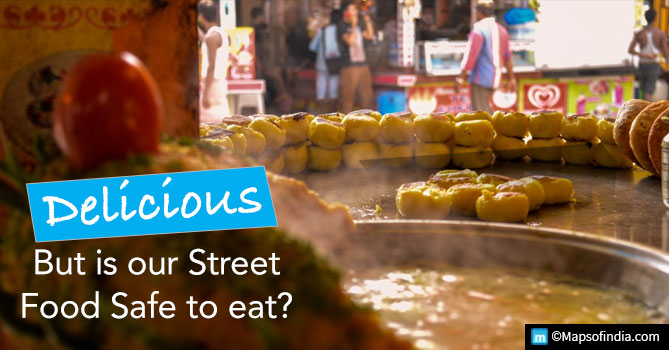Be it the crunchy, mouth-watering gol gappas of Chandni Chowk, or the delicious kachori from Connaught Place, the life of an average Indian feels incomplete without street food. And why not? It is more delicious than what many fancy restaurants can promise, and it fits right into our pockets! It’s the one food everybody loves, no matter what the class, what the background. But unfortunately, all is not rainbows and sunshines. With no intention of taking your occasional guilty pleasure of eating paav bhaji away, we put in a quick question here. How hygienic do you think our street food really is?
A reality check
A study conducted by the Institute of Hotel Management (IHM) in 2015 revealed some highly shocking results. In the samples collected from famous street food joints, the institute found traces of faecal matter (excrement product) in items like gol gappas. A bacteria called E. Coli was also present in high amounts. The bacteria is known to cause problems like diarrhea, gastroenteritis etc.
Delhi Street Food: A Gastronome’s Delight
Keeping the research data aside, our minds are guaranteed to fall into a dubious state even if we simply consider the areas we get our favorite street food from. Most of the vendors have their stalls in the open, usually on roadsides or in street corners. Some are conveniently placed inches away from public washrooms. How hygienic that is, is not too difficult a question to answer. With the exception being of a few small-scale vendors, and mainstream street food joints, gloves are rarely used for serving or preparing the food. The risk on safety increases further in case of food items like bhelpuri etc since they also use raw vegetables, the sanitation of which is questionable.
Are fruits or fruit juice really a safer alternative?
Do you doubt the safety of street food, and hence, choose to consume fruit juice/ fruits from your local vendor? If yes, you might need to reconsider your choices. It will sound shocking, but your attempts to switch to a healthier lifestyle might actually be doing you more harm than good.
Vitamin Deficiencies – India’s Health And Nutrition Crisis
Not only is there a lack of guarantee about the utensils used being clean, the ice that is put in fruit juice often comes from highly unclean water sources. It is therefore highly recommended that you think twice before hopping onto another fruit juice stall.
In summers, you will find rows after rows of vendors offering you ‘fresh’ cut fruits to beat the scorching heat. Tempting, yes. But healthy? Maybe not so much.Jaundice – Causes, Symptoms, and Prevention
It is generally advised to store cut fruits in a cool place, properly covered. However, that is hardly the storage conditions we find on our roadsides. Without the right treatment, cut fruits have high chances of being contaminated with bacteria.
How can you protect yourself?
While there are certain precautions you should keep in mind, the good news is, you don’t have to say “goodbye” to your favorite snacks. Here, we list down a couple of things you should remember the next time you are out for an eating spree:
1) Make sure the utensils are clean- the one that your food is made in, as well as the one you are being served in.
2) Check how hygienic the surroundings are.
3) Confirm that the seller has gloves on.
4) In case you are going for a glass of juice or shake, avoid getting ice put in. Also, make sure the jug, glass etc used are clean.
5) Avoid eating cut fruits from the roadside.While we may blame the local vendors for the poor quality of street food, that point of view is highly narrow. The International Journal of Community Medicine and Health published a research paper in early 2018, concluding that “the street food vendors were aware of food hygiene and had favourable attitude towards it, but it wasn’t translated in their hygiene practice”. The reason for the same can be found out easily, at least the partial cause. The street vendors usually lack the appropriate resources to implement a cleaner, healthier system of providing food. Hence, even if they might genuinely wish to change the structure, they simply cannot.
Where does the government fit in?
In 2017, the Food Safety and Standards Authority of India (FSSAI), along with Ministry of Skill Development and Entrepreneurship launched a “one of its kind” initiative in the national capital. Approximately 23,000 street vendors were trained on basic health standards and sanitation. On completion, they were given certificates, as well as a kit containing necessities like apron, gloves etc.
Communicable Diseases are still Prevalent
With willing vendors and government initiatives, the condition of street food can be improved tremendously. While that wheel of change is set in motion, as an aware consumer, we must put in our personal set of precautions. And while you do that, make sure you enjoy your delicious treats!
India How safe is our Indian street food?





